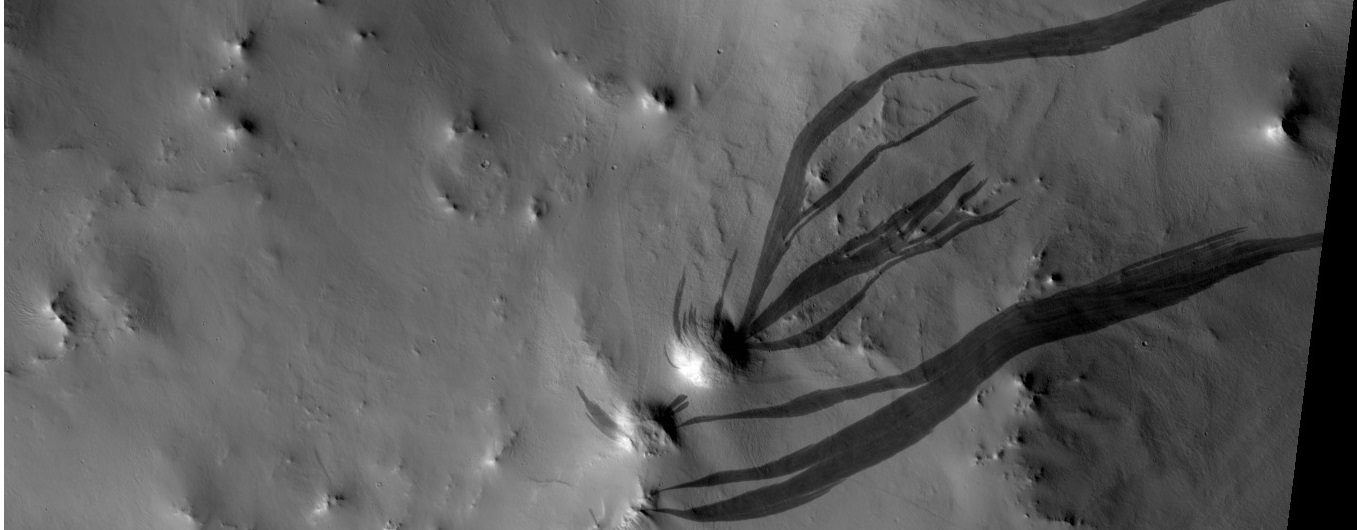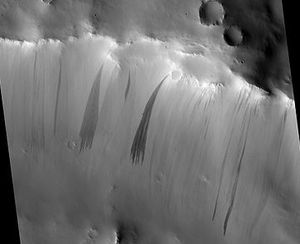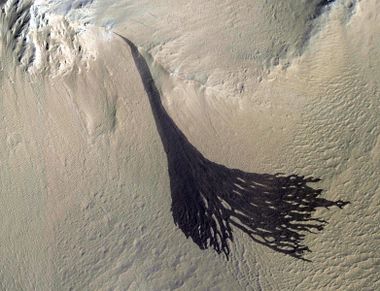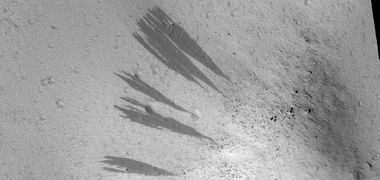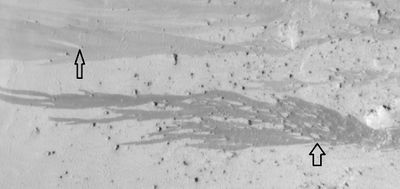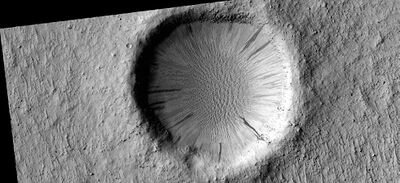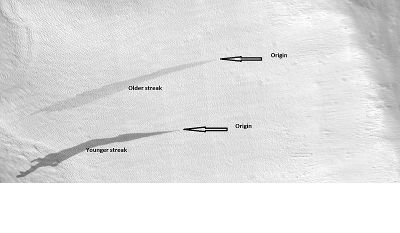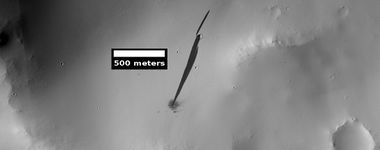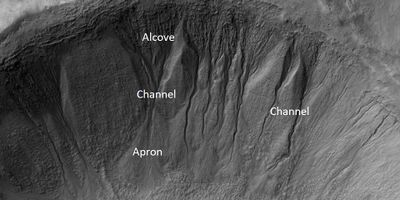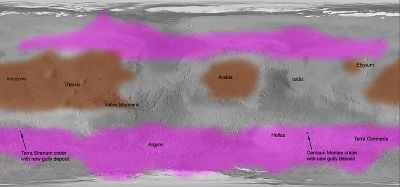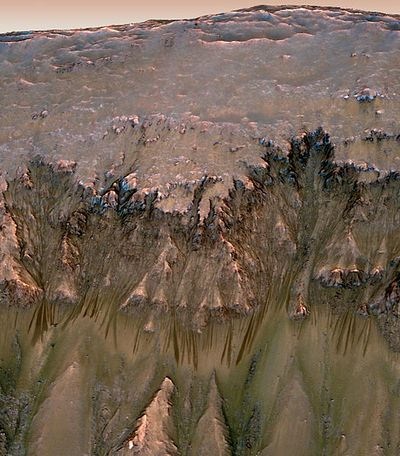Dark slope streaks
Dark slope streaks, as seen by HiRISE
Dark slope streaks are found on Mars on dust-covered slopes often near the equator; they are believed to be avalanches involving bright Martian dust moving down slope and exposing the dark underlying rock. However, some researchers suggest that water may be involved.[1]
Contents
Appearance
Dark slope streaks are found on dust-covered slopes, particular near the equator.[2] They have never been observed on the Earth.[3]
The streaks start out only about 10% darker than their surroundings.[4] Many images of the streaks have been post-processed to bring out more detail and appear much darker. Over time these streaks tend to get lighter as the brighter Martian dust settles from the atmosphere. The darker ones are the newest.
Typically, streaks begin at a small point high on a steep slope, such as a crater wall.[5] And then they greatly widen and sometimes divide into finger-like extensions (digitation). Obstacles, such as boulders, may cause an individual streak to split into two separate streaks or eventually form a braided (anastomosing) pattern.[6] Slopes can change their direction.[7] Many have a fan shape. [8]
Streaks may be hundreds of meters long with a width of 20 to 200 meters.[9] Indeed, some can be over 2 kilometers long. [10] [11] [12]
How long do they last?
Thanks to the many excellent cameras that we have placed in orbit over many decades, we have a history of how the Martian surface changes. Dark slope streaks are some of the most changing parts of Mars. They were discovered in Viking Orbiter pictures from the 1970.[13] [14] When images from Mars Global Surveyor (MGS) and Mars Reconnaissance Orbiter (MRO) spacecraft are compared, the life history of streaks can be precisely determined.[15] [16] [17] [18] [19]
One analysis concluded that 70 streaks per day may form on the planet. The research team compared overlapping images from Mars Global Surveyor Mars Orbiter Camera that were spaced days to years apart. [20] Dark slope streaks are constantly forming and fading. The darker ones are the youngest. Fading is accomplished by settling of bright dust in the Martian atmosphere. When researches looked at a small area (Lycus Sulci) on Mars with both Viking images and recent CTX images from the Mars Reconnaissance Orbiter, they found that the ones seen in Viking photos were gone, however, new streaks have taken their place. Their calculations indicated that slope streaks last about 40 years [21]
It is believed that during Mars' global dust storms many - perhaps most - streaks and other features are erased during these occosional occurences.[22] [23]
What causes dark slope streaks?
Although many ideas have been put forward to explain slope streaks, the general opinion today is that they are simply avalanches of darker colored dust.[24] [25] [26] Nearly all of Mars is covered with a thin, bright dust. On steep slopes this layer of dust can move away and reveal a dark surface. The dark volcanic rock basalt lies under the lighter-toned dust which falls out of the atmosphere. In a study of over 500,000 dark slope streaks, researchers found that streaks were more likey to form in dusty areas instead of moist places. The authors also determined that slope streaks modify less than 0.1% of the martian surface, but transport several global storm equivalents of dust per Mars year; hence, potentially playing a major role in the martian dust cycle." [27] [28] With the long term observations from orbit, researchers have noticed that strikes by meteorites can start the process of slope formation.[29] [30] Moreover, even the air blast from an oncoming strike can trigger clusters of slopes to form.[31] However, some researchers have put forth a "wet model" in which liquid water is involved.[32] [33]
Although event like meteorite impact nearby can trigger the formation of streaks, surface temperature and wind velocity may be connected to dark slope streak formation. This conclusion was described in a recent article in the journal Icarus.[34] It has been found that streaks can start when dry ice in the ground turns into a gas. Dry ice turning into a gas can make a wind that disturbs the dust; thus starting it to move down a slope. Dry ice can form under the surface as temperature drops.[35] [36]
Dust devils have been observed to start the formation of dark slope streaks.[37] [38]
Marsquakes may be involved in starting dark slope streaks. A team of researchers found an increase in dark slope streaks after S1222, a marsquake that was detected by the Insight lander. The quake occured on On May 4, 2022.
[39]
More views of dark slope streaks
Other slope features
Several features are common on slopes on Mars. The surface of Mars is billions of years old in most
places. Consequently, it has accumulated many steep slopes, especially in craters and canyons. Although streaks, gullies, and recurring slope lineae all occur on slopes, they have different origins.
Martian gullies show up in certain zones. However, unlike dark slope streaks they go fairly deep into the surface and are not erased by falling dust over time. Their origin is still debated. For over a decade they were believed to be formed by recent, flowing water.
[40]
[41]
[42]
[43] Now, new observations suggest that gullies are being made today by chunks of dry ice moving down steep slopes in the spring.
[44]
[45]
[46]
[47]
[48]
[49]
[50]
[51]
Gullies and streaks are found in different areas on the planet. While the streaks are towards the equator, gullies are often found in the middle northern and southern hemispheres.
Like gullies and streaks, recurring slope lineae are seen on steep slopes, but they are smaller, more narrow, and straighter. Since they seem to lengthen as the temperature increases, they were believed to be involved with liquid water.[52] [53] [54] [55] [56] [57] Nevertheless, later studies showed that very little water, if any, could be involved.[58] [59] [60] [61] [62] As more and more observations were gathered, researchers leaned more and more to liquid water not being involved with these types of streaks. Since there are more streaks when more dust devils are present, researchers think wind may be involved.[63] [64]
References
- ↑ A. Bhardwaj, L. Sam, F.J. Martín-Torres, M.P. Zorzano. 2019. Are slope streaks indicative of global-scale aqueous processes on contemporary Mars? Rev. Geophys. 10.1029/2018RG000617
- ↑ Chuang, F.C.; Beyer, R.A.; Bridges, N.T. (2010). Modification of Martian Slope Streaks by Eolian Processes. Icarus, 205 154–164.
- ↑ Heyer, T., et al. 2019. Seasonal formation rates of martian slope streaks. Icarus
- ↑ Sullivan, R. et al. 2001. Mass Movement Slope Streaks Imaged by the Mars Orbiter Camera. J. Geophys. Res., 106(E10), 23,607–23,633.
- ↑ Schorghofer, N.; Aharonson, O.; Khatiwala, S. 2002. Slope Streaks on Mars: Correlations with Surface Properties and the Potential Role of Water. Geophys. Res. Lett., 29(23), 2126.
- ↑ Chuang, F.C. et al. 2007. HiRISE Observations of Slope Streaks on Mars. Geophys. Res. Lett., 34 L20204.
- ↑ https://www.uahirise.org/ESP_021976_2055
- ↑ Sullivan, R. et al. 2001. Mass Movement Slope Streaks Imaged by the Mars Orbiter Camera. J. Geophys. Res., 106(E10), 23,607–23,633.
- ↑ http://viewer.mars.asu.edu/planetview/inst/moc/M1600596#P=M1600596&T=2
- ↑ Sullivan, R. et al. 2001. Mass Movement Slope Streaks Imaged by the Mars Orbiter Camera. J. Geophys. Res., 106(E10), 23,607–23,633.
- ↑ Chuang, F.C.; Beyer, R.A.; Bridges, N.T. 2010. Modification of Martian Slope Streaks by Eolian Processes. Icarus, 205 154–164.
- ↑ Baratoux, D. et al. 2006. The Role of the Wind-Transported Dust in Slope Streaks Activity: Evidence from the HRSC Data. Icarus, 183 30–45.
- ↑ Morris, E.C. (1982). Aureole Deposits of the Martian Volcano Olympus Mons. J. Geophys. Res., 87(B2), 1164–1178.
- ↑ Ferguson,H.M.; Lucchitta, B.K. (1984). Dark Streaks on Talus Slopes, Mars in Reports of the Planetary Geology Program 1983, NASA Tech. Memo., TM-86246, pp. 188–190. https://ntrs.nasa.gov/archive/nasa/casi.ntrs.nasa.gov/19840015363_1984015363.pdf.
- ↑ Sullivan, R. et al. (2001). Mass Movement Slope Streaks Imaged by the Mars Orbiter Camera. J. Geophys. Res., 106(E10), 23,607–23,633.
- ↑ Chuang, F.C. et al. 2007. HiRISE Observations of Slope Streaks on Mars. 'Geophys. Res. Lett. 34 L20204.
- ↑ Dundas, C. 2018. HIRISE OBSERVATIONS OF NEW MARTIAN SLOPE STREAKS. 49th Lunar and Planetary Science Conference 2018 (LPI Contrib. No. 2083). 2026.pdf
- ↑ Malin, M.C.; Edgett, K.S. (2001). Mars Global Surveyor Mars Orbiter Camera: Interplanetary cruise through primary mission. J. Geophys. Res., 106(E10), 23,429–23,570.
- ↑ Edgett, K.S.; Malin, M.C.; Sullivan, R.J.; Thomas, P.; Veverka, J. (2000). Dynamic Mars: New Dark Slope Streaks Observed on Annual and Decadal Time Scales. 31st Lunar and Planetary Science Conference, Abstract #1058. http://www.lpi.usra.edu/meetings/lpsc2000/pdf/1058.pdf.
- ↑ Aharonson, O.; Schorghofer, N.; Gerstell, M.F. (2003). Slope Streak Formation and Dust Deposition Rates on Mars. J. Geophys. Res., 108(E12), 5138, doi:10.1029/2003JE002123.
- ↑ Bergonio, J., K. Rottas, and N. Schorghofer. 2013. Properties of martian slope streak populations: 225. Icarus: 194-199.
- ↑ Aharonson, O.; Schorghofer, N.; Gerstell, M.F. 2003. S lope Streak Formation and Dust Deposition Rates on Mars. J. Geophys. Res., 108(E12), 5138, doi:10.1029/2003JE002123.
- ↑ Schorghofer, Aharonson, O.; Gerstell, M.F.; Tatsumi, L. 2007. Three Decades of Slope Streak Activity on Mars. Icarus: 191, 132–140. doi:10.1016/j.icarus.2007.04.026.
- ↑ https://www.uahirise.org/hipod/ESP_022991_2070
- ↑ https://www.uahirise.org/PSP_009192_1890
- ↑ Treiman, A.H.; Louge, M.Y. (2004). Martian Slope Streaks and Gullies: Origins as Dry Granular Flows. 35th Lunar and Planetary Science Conference, Abstract #1323. http://www.lpi.usra.edu/meetings/lpsc2004/pdf/1323.pdf
- ↑ Valentin, T. and A. Valantinas. 2025. Streaks on martian slopes are dry. Nature Communications.
- ↑ https://www.space.com/astronomy/mars/dark-streaks-on-mars-may-not-come-from-water-after-all-scientists-say?utm_term=CABA215D-3D47-4C9A-92FE-9ECF8D4C7909&lrh=e62336263a3610a07ef7c8af2080c758f2ecd0661aab1a8e6234cf31f0d0fdff&utm_campaign=58E4DE65-C57F-4CD3-9A5A-609994E2C5A9&utm_medium=email&utm_content=CC262A6E-5136-48F9-B124-6B5979B0DBA3&utm_source=SmartBrief
- ↑ http://www.uahirise.org/epo/nuggets/dust-avalanche.pdf
- ↑ https://hirise.lpl.arizona.edu/ESP_054066_1920
- ↑ Kaylan J. Burleigh, Henry J. Melosh, Livio L. Tornabene, Boris Ivanov, Alfred S. McEwen, Ingrid J. Daubar. 2012. Impact air blast triggers dust avalanches on Mars Icarus: 217 (1) 194 doi:10.1016/j.icarus.2011.10.026
- ↑ Junior, C. and T. Statella. 2023. Monitoring martian slope streaks in the northeast of Lysus sulci. Icarus. 406: 115737.
- ↑ Bhardwaj, A., et al. 2018. Are Slope Streaks Indicative of Global-Scale Aqueous Processes on Contemporary Mars? Reviews of Geophysics: Volume 57, Issue 1 p. 48-77
- ↑ Heyer, T., et al. 2019. Seasonal formation rates of martian slope streaks. Icarus
- ↑ https://agupubs.onlinelibrary.wiley.com/doi/10.1029/2021JE006988
- ↑ Lange, S., et al. 2022. Gardening of the Martian Regolith by Diurnal CO2 Frost and the Formation of Slope Streaks. JGR Planets. Volume127, Issue4. e2021JE006988
- ↑ https://www-sciencedirect-com.wikipedialibrary.idm.oclc.org/science/article/pii/S0019103520303249#bb0020
- ↑ Heyer, T., et al. 2020. Dust devil triggering of slope streaks on Mars. Icarus. Icarus Volume 351. 113951
- ↑ Lucas, A. et al. 2024. S1222a marsquake. Icarus. Volume 411. 115942
- ↑ Malin, M.; Edgett, K. (2000). "Evidence for recent groundwater seepage and surface runoff on Mars". Science. 288: 2330–2335.
- ↑ Luu, K., et al. 2018. GULLY FORMATION ON THE NORTHWESTERN SLOPE OF PALIKIR CRATER, MARS 49th Lunar and Planetary Science Conference 2018 (LPI Contrib. No. 2083). 2650.pdf
- ↑ Hamid, S., V. Gulick. 2018. GEOMORPHOLOGICAL ANALYSIS OF GULLIES ALONG WESTERN SLOPES OF PALIKIR CRATER. 49th Lunar and Planetary Science Conference 2018 (LPI Contrib. No. 2083). 2644.pdf
- ↑ Tyler Paladin, T., et al. 2018. INSIGHTS INTO THE FORMATION OF GULLIES IN ASIMOV CRATER, MARS. 49th Lunar and Planetary Science Conference 2018 (LPI Contrib. No. 2083). 2889.pdf
- ↑ Dundas, C., S. Diniega, A. McEwen. 2015. Long-term monitoring of martian gully formation and evolution with MRO/HiRISE. Icarus: 251, 244–263
- ↑ Fergason, R., C. Dundas, R. Anderson. 2015. IN-DEPTH REGIONAL ASSESSMENT OF THERMOPHYSICAL PROPERTIES OF ACTIVE GULLIES ON MARS. 46th Lunar and Planetary Science Conference. 2009.pdf
- ↑ Dundas, C. et al. 2016. HOW WET IS RECENT MARS? INSIGHTS FROM GULLIES AND RSL. 47th Lunar and Planetary Science Conference (2016) 2327.pdf.
- ↑ Vincendon, M. 2015. Identification of Mars gully activity types associated with ice composition.JGR:120, 1859–1879.
- ↑ Raack, J.; et al. (2015). "Present-day seasonal gully activity in a south polar pit (Sisyphi Cavi) on Mars". Icarus. 251: 226–243. Bibcode:2015Icar..251..226R. doi:10.1016/j.icarus.2014.03.040.
- ↑ http://www.uahirise.org/ESP_044327_1375
- ↑ C. Pilorget, C., F. Forget. 2015. "CO2 Driven Formation of Gullies on Mars." 46th Lunar and Planetary Science Conference. 2471.pdf
- ↑ Pilorget, C.; Forget, F. (2016). "Formation of gullies on Mars by debris flows triggered by CO2 sublimation". Nature Geoscience. 9: 65–69. Bibcode:2016NatGe...9...65P.
- ↑ Stillman, D., et al. 2017. Characteristics of the numerous and widespread recurring slope lineae (RSL) in Valles Marineris, Mars. Icarus. Volume 285. Pages 195-210
- ↑ McEwen, A. et al. 2011. Seasonal Flows on Warm Martian Slopes. Science, 333(6043), 740–743. doi:10.1126/science.1204816 PMID 21817049. http://www.sciencemag.org/content/333/6043/740.
- ↑ Mann, Adam (18 February 2014). "Strange Dark Streaks on Mars Get More and More Mysterious". Wired. Retrieved 18 February 2014.
- ↑ Chang, K. 2011. "Scientists Find Signs Water Is Flowing on Mars," New York Times, August 4, A13. https://www.nytimes.com/2011/08/05/science/space/05mars.html?_r=1&ref=marsplanet.
- ↑ HiRISE website. Seasonal Flows on Warm Martian Slopes. http://hirise.lpl.arizona.edu/sim/science-2011-aug-4.php.
- ↑ McEwen, A. Ojha L.; Dundas C.; Mattson, S.; Byrne S.; Wray J.; Cull S.; Murchie S. 2011. Transient Slope Lineae: Evidence for Summertime Briny Flows on Mars? 42nd Lunar and Planetary Science Conference, Abstract #2314. http://www.lpi.usra.edu/meetings/lpsc2011/pdf/2314.pdf.
- ↑ Dundas, C., et al. 2017. Granular Flows at Recurring Slope Lineae on Mars Indicate a Limited Role for Liquid Water. Nature Geoscience. Nov. 20. [1].
- ↑ Schaefer, E., et al. 2018. A case study of recurring slope lineae (RSL) at Tivat crater: Implications for RSL origins. Icarus: In press. https://doi.org/10.1016/j.icarus.2018.07.014
- ↑ https://advances.sciencemag.org/content/7/6/eabe4459
- ↑ https://www.livescience.com/mars-mysterious-dark-streaks-landslides.html?utm_source=Selligent&utm_medium=email&utm_campaign=LVS_newsletter&utm_content=LVS_newsletter+&utm_term=2946561
- ↑ Mason, D. and L. Scuderi. 2023. Interweaving RSL on Mars: Do They Support a Wet Hypothesis? 54th Lunar and Planetary Science Conference 2023 (LPI Contrib. No. 2806). 1703.pdf
- ↑ https://www.space.com/mars-dark-streaks-probably-not-water?utm_source=Selligent&utm_medium=email&utm_campaign=SDC_Newsletter&utm_content=SDC_Newsletter+&utm_term=2946561
- ↑ McEwen, A., et al. 2021. Mars: Abundant Recurring Slope Lineae (RSL) Following the Planet‐Encircling Dust Event (PEDE) of 2018. JGR Planets
See also
External links
- Lucas, A. et al. 2024. S1222a marsquake. Icarus. Volume 411. 115942
